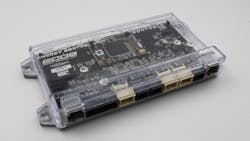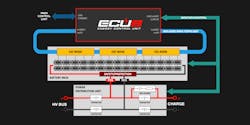A Peek Inside a Modern EV Battery-Management System
This article is part of the TechXchange: EV Battery Management.
Every electric vehicle (EV) is packed with as many lithium-ion (Li-ion) battery cells as possible to boost the energy-storage capacity of the pack housing them, which is the single most expensive component under the EV’s hood.
Since it’s necessary to carefully manage the charging and discharging of these (sometimes combustible) assets, the battery-management system (BMS) plays an increasingly pivotal role in EVs. The BMS is the backbone of the EV’s entire power-delivery system, accurately monitoring each cell in the high-voltage battery pack over its lifetime to ensure that they’re operating safely and reliably with optimal performance.
In that context, Neutron Controls has partnered with Infineon Technologies to roll out its latest BMS platform with a robust ASIL D rating for functional safety. The goal is to give their mutual customers a pre-made solution based on existing Infineon power-management and other ICs to help accelerate the engineering of hardware and software for an EV BMS and, in turn, reduce time and cost for engineers.
The new ECU8—ECU stands for electronic control unit—can monitor up to 12 Li-ion battery cells per module. The system can scale to support up to 1-kV batteries by combining up to 20 modules. For flexible integration, it contains a wide range of communication interfaces, including isolated UART and SPI buses, dual Ethernet ports, triple CAN FD ports, as well as high- and low-side drivers for external contactors.
While it’s a development platform, the ECU8 also provides a window into how a modern BMS works and what it takes to monitor and manage high-voltage EV battery packs effectively and safely.
Understanding the Role of the BMS in EVs
In general, improvements in EV batteries stem from the use of new materials, chemistries, and hardware that often come with very long development cycles as well as tradeoffs in performance, safety, and cost.
But building a better BMS opens the door to improved performance metrics—namely, energy density, fast charge capability, safety, and cycle life—without grappling with the same tradeoffs.
By monitoring the state of health (SOH) and state of charge (SOC) of the Li-ion battery pack, the BMS not only protects it from damage that can hurt its performance or cause premature deterioration, but it can also maximize the EV battery’s capacity. By gaining a better understanding of the internal state of the cells, the BMS enables more optimal use of the battery’s energy reserves.
For instance, faster charging times are possible by using information from the battery pack during charging to track the internal state of Li-ion cells for signs of lithium plating. Charging currents can be reduced when lithium plating starts to occur and then increased when the threat is no longer present. Thus, you can increase the average charging power without hastening degradation.
The BMS must also accurately measure what’s happening inside a battery pack to protect it from harm. The current generation of Li-ion batteries in cars now are feats of engineering, packing huge amounts of energy into a small envelope with slow self-discharge rates and the ability to handle higher voltages. But despite the advantages of the latest Li-ion formulations, they also tend to be very fragile.
If the battery cells are damaged or incorrectly charged or drained, they can overheat uncontrollably in a "thermal runaway" that could end up being explosive. Overcharging and undercharging may also devastate battery cells. They can become stressed, leading to premature charge termination and a reduction in the battery’s useful life. Sudden surges in voltage, temperature, and current could also deal permanent harm.
The Hardware Under the Hood of a BMS
At the heart of the platform is Infineon’s AURIX TC3xx MCU, which is suited for managing the charging and discharging of EV batteries thanks to its combination of performance, functional safety, and power efficiency.
Infineon said the 32-bit TC3xx family contains up to six TriCore CPU cores clocked at 300 MHz. Delivering up to 4,000 DMIPS, the MCU brings robust computational power to the table. Connectivity features include dual 1-GB/s Ethernet and 12 CAN FD interfaces.
The TC3xx MCU features up to 16 MB of flash memory and up to 6.9 MB of SRAM, giving customers ample storage for algorithms and data alike. The MCU, which can be configured to take care of SOC and SOH calculations for the battery pack, can also be seamlessly updated over the air (OTA), meaning the BMS can be upgraded over time without having to shut it down entirely.
The MCU is paired with a separate power-management IC, the TLF35584. It includes a wide range of safety features, including watchdog timers, to support up to ASIL D functional safety at the system level.
Every cell in the battery pack must be wired to a battery-management IC (BMIC)—in the Neutron’s ECU, it’s the TLE9012 from Infineon—that’s used to watch over the voltage, current, and other aspects of the battery cells to keep them from expending precious energy. The capacity of Li-ion cells diminishes over time and usage; therefore, every cell needs to be managed and regulated to keep it within a safe charge level and maximize the energy that’s extracted and in turn used to recharge it.
The TLE9012 can accurately measure the voltage in up to 12 battery cells to within ± 5.8 mV over the full temperature and voltage range of the cells and over their useful life. Even minute improvements in the measurement accuracy of these chips can have a significant impact on EV range.
Passive cell balancing is handled by 12 switches integrated on the chip—one for each of the 12 channels—suiting it for batteries that are partitioned with 12 cells per module. Using Infineon’s iso-UART interface for isolated communications between them, the TLE9012 outputs currents up to 150 mA to correct differences in the SOC of the independent battery cells. If even higher currents are required, it can be equipped with external switches.
The BMIC can also support up to five external temperature sensors to stay alert to overheating. Furthermore, it takes into account the temperature or other harsh environmental conditions and corrects measurements accordingly.
Software: The Secret to Managing EV Battery Packs
The iso-UART interface shares data reliably between these collections of battery cells that are bundled into full battery packs placed in the EV’s underbelly. The ECU uses Infineon’s TLE9015 to connect several of the TLE9012s in a daisy chain inside the battery pack.
The transceiver IC connects 20 devices in series. It supports a “ring” topology to make sure that, even if a single device fails, the communication will continue, and the rest of the system will function. A pair of UART ports are used to connect to the host MCU.
While hardware is at the heart of any BMS, software is a key piece of the puzzle, too. Neutron said the ECU8 is not only a reference design for customers to build on top of, but it’s also a software development tool.
Advanced BMS software allows for EV batteries to be charged to a higher level and discharged to a lower level without being damaged or aging prematurely, increasing their usable capacity and the EV’s range per charge. It can also enable faster charging and minimize degradation to extend the battery’s lifespan, easing stress on the supply chain for batteries, which is limited by restricted supplies of critical minerals.
Another key factor in this is the high cost of large, high-voltage batteries and the persistent difficulties in scaling production to match the rapidly growing demand. Software presents a way to solve both issues.
By reducing the volume of batteries without diminishing their range or by spreading out the cost of building EV battery packs over a longer lifetime, such software could save car makers up to $18 billion a year by 2030, according to estimates by technology research firm ABI Research. “ These solutions can be adopted purely through software, running as AUTOSAR applications to augment the existing BMS capabilities,” said Dylan Khoo, EV technology analyst at ABI.
“The BMS software effectively gets more energy out of a smaller battery,” added Khoo. “As an application layer solution, it can be applied to a wide range of battery formats without requiring changes in design or manufacturing.”
Read more articles in the TechXchange: EV Battery Management.
About the Author
James Morra
Senior Editor
James Morra is the senior editor for Electronic Design, covering the semiconductor industry and new technology trends, with a focus on power electronics and power management. He also reports on the business behind electrical engineering, including the electronics supply chain. He joined Electronic Design in 2015 and is based in Chicago, Illinois.



